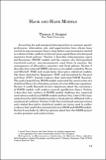Artículo
Haok and hank models
Fecha
2024Resumen
Accounting for and managing heterogeneities in economic agents’ preferences, information sets, and opportunities have always been central to macroeconomic theory. Long before macroeconomics existed as a distinct field, conflicts of interest preoccupied those who designed monetary-fiscal policies.1 Section 1 describes heterogeneous agent old Keynesian (HAOK) models and the reasons why distinguished twentieth-century macroeconomists used them to analyze the consequences of alternative monetary and fiscal policies. Section 2 describes how informal NBER reference cycle models created by Burns and Mitchell (1946) and single-factor descriptive statistical models, like those sketched by Koopmans (1947) and formalized by Sargent and Sims (1977), framed evidence that motivated HAOK theorists.
Colecciones
Descargar

El ítem tiene asociados los siguientes ficheros de licencia:

